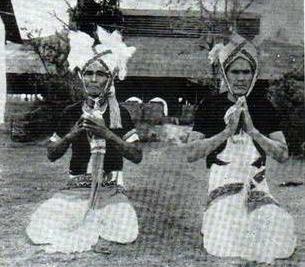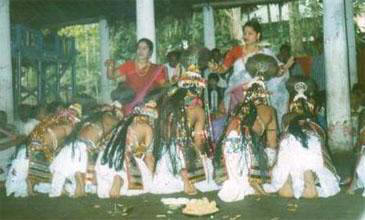|

Manipur
was known by different names by different neighbouring people in
ancient and medieval times. To quote W. McCulloch, "The country
inhabited by the Muneepoorees is by the inhabitants of Cachar it is
named Moglei ; by those of Assam Mekhlee and by the Shans or those who
inhabit the country east of Ningthee or Khyendwen river it is known as
Cassay of which term the Burmese word Kathe is a corruption." The
narrative of Symes and the maps of that period give the name "Cassay"
to this country. In Rennell's Memoir and maps of India it is mentioned
as "Meklee." Other popular names by which it is known are Manipur,
Sanaleibaak and Kangleipak.
There are number of folk stories and legends regarding human
inhabitation in Manipur valley. There is a living popular tradition in
Manipur that it represents the old kingdom mentioned in the Hindu Epic
Mahabharata. Some of the Manipuri Scholars like Pandit Atombapu
Sharma, W.Yamjao Singh and R.K. Jhaljit Singh hold that the people of
Manipur are the descendants of group of people coming from Mithila (Videha)
mentioned in Mahabharata. But there is reasonable doubt
whether the present Manipur is that of the Mahabharata. Scholars have different
opinions as well as views regarding the exact location of the Manipur
mentioned in Mahabharata with the present.

The
installation of Chaithaba: the incoming and outgoing
Apart from folk stories and legends, there are historical evidences of
a stable kingdom with Imphal as its capital under Pakhangba, the first
king of Manipur, in the first century. The land was formerly divided
into small territories occupied by different clans of peoples, namely
Khumal, Moirang, Angom, Luwangs, Ningthoujas, etc. The territories
were after the names of the respective clans and they lived side by
side in Manipur for centuries until the Ningthouja clan occupied all
by degrees.
The people of Manipur comprise both the migrants of East and West who
came to Manipur in different periods of history. During the earlier
period migrants were in general assimilated and assigned to one or
other to the clans, no doubt according to the area in which they
settled. There origins were remembered by the terms
Nongpok
Haram and
Nongchup Haram.
Nongpok
Haram
(The Mongoloid migrants from the East, mainly the Shans, Kabaws
and Pongs, a little of Chinese and Burmese),
Nongchup Haram (The Dravidian and Aryan migrants from the West, mainly the Bishnupriya's, the Brahmins etc.).
The history of Manipur witnesses
the process of racial fusion undermining the geographical features. So
the mass people of Manipur is a composite one to which the Mongoloids,
Dravidians, Aryans, Pongs, Chinese, Siamese, etc, were contributory.


Although common Manipuri thought is
identified with Hinduism in form of Vaishnvism which is associated
with the School of Sri-Chaytanya, there is a basic philosophy in
existence outside Hinduism. The fact is Vaishnavism practiced in
Manipur consequently became a peculiarly Manipuri Vaishnvism in form,
adopting aspects of olden culture and modified by it.
The ancient Manipuris had their
own thought and philosophy, own Gods and Priests, own rites and
festivals which preserved a religion rich in mythology and colorful in
ritual. The Manipuri religion, i.e., the religion practiced by the
Manipuris in the olden days said to be the oldest religion in
South-East Asia. Early Manipuris were devotees of Supreme Almighty God
"Lainingthou Soralel" following the Laining-Lichat (Footprint) of
Godly ancestors. The religious life of the people, even when they have
come much under the influence of Hinduism, retains many
characteristics inherited from their prehistoric ancestors. The
essentials of this religion remain recognizable to the present day.
Nowadays it is clearly found and seen that there are two main types
of Manipuris-
(i) Manipuri Vaishnavs: Manipuris adopting Goudiya Vaishnavism but retain
characteristics of the old faith and philosophy, worshipping Hindu deities along with
the traditional Gods like Sanamahi, Pakhangba and Leimaren.
(ii) Indigenous Manipuris: Manipuris
devoted to Supreme Almighty God "Lainingthou" following the
Laining-Lichat (Footprint) of Godly forefathers.

The Umang Lai's
The term "Umang
Lai" is used generally to cover all the catagories of manipuri
gods, although it has a narrower meaning when it applied specifically
with Sacred groves. Etymologically the term Umang Lai means Forest or
Wood deity (Umang=forest,Lai=god), but in many cases deities termed
Umang Lai's have no connection with trees whatsoever. Umang Lais can
be classified broadly into four catagories -
-
Ancestral Gods : Ancestors or
Gods that were believed to have had a human existence at past.
Examples are Pakhangba, Nompok Panthoibi etc.
-
Gods associated with yek's :
Gods associated with particular yek's or Salai. For example, Thangjing
is the god of the Moirangs, Okmaren as for the Khumans etc.
-
Domestic Deities : The Yumjai
Lai's or clan gods associated with particular clan or family
groups(Sagei). Traditionaly there are 445 Sagei's, each of which has
its own Lai's. Houshold deities like Sanamahi, Leimaren and Phungga
fells into this catagory.
-
Tutelary Deities : Guardian
spirit connected with prtocular place or areas. For example, Marjing
is the guardian of North-East.

Tree Cults of Ancient Manipur...
Trees are worshipped or given very high magico-religious value by
the Meeteis as an integral part of the Manipuri tradition of
nature worship. There are manu references in the Chaitharol
Kumbaba which shows that tree reverence was very common during the
pre-Hindu periods. Worship of the Tree consist of bowing and
sometimes offering of fruits and flowers. The religious
significance of plants like tairem is seen during rituals like Lai
Haraoba and Yumsengba.
|
Plants worshipped |
Plants given
magical-religious importance |
|
Ficus
religiosa (Peepul) |
Toona
ciliata (Australian Red Cidar) |
|
Ficus
bengalensis (Banyan) |
Dactyloctenum
aegypticum (Crowfoot grass) |
|
Hydnocarpus
kurjii |
Blumea
balsamifera (Camphor) |
|
Mangifera
indica (Mango) |
Mangifera
indica |
|
Ocimum
sanctum (Sacred Basil) |
Ocimum
sanctum |
|
Terminalia
arjuna |
Cynodon
dactylon (Bermuda or Durva grass) |
| |
Aegle
marmalos (Wood apple) |
| |
Xylosoma
longifolia |
| |
Oroxylum
indicum |
| |
Plectranthus
ternifolius |
|
Some plants like mango, wood apple, Bermuda or 'durva' grass, and
sacred basil (Ocimum sanctum) are either worshipped or used in
religious rituals by the Hindus all over India. It is, therefore,
obvious that these plants were included by the Meeteis under the
Hindu Vaishnavite influence.
Plants taboo on specific days or periods, or to a particular clan
is still preserved by orthodox Manipuris. It is a custom for the
Maiba-Maibi (priest and priestess) of Manipur to always ask
forgiveness of a tree whenever it is cut for some purpose. Some
plant taboos observed are -
-
Bamboo is not harvested on Tuesday, Thursday, and Saturday, and on
new moon days,
-
Banana not harvested on Saturday,
-
Hatoda Vasica not harvested on Sunday because Sunday is the
birthday of this plant,
-
Water dropwort or water parsley not consumed during
August-September because violator will have worms in stomach,
-
Luffa cylindrica not consumed by the Ningthouja clan.

Sacred Stones...
There are evidences that acred stones are worshipped by the people
in the early days. The cultic significance of stones among the early
Meeteis was remarkable. The Moirang cultic hero 'Yaosurakpa' said to
be transformed himself into a stone. Two sacred stones are situated at
Thangjing where annual Lai-Haraoba is held. A funeral in Kangla also
marked by a stone.
In the manuscript called "Shagokshading", there is a list of such
sacred stones which have cultic significances. Several of the stones
claimed to have supernatural powers whatsoever.

The Meetei Lai's...
The number of deities worshipped by the Manipuri Meeteis, is computed
to be three hundred and sixty four in addition to the three members of
trinity, i.e, Pakhangba, Sanamahi and Leimaren Sidabi . The supreme
god is Atiya Guru Sidaba or Sidaba Mapu. For purpose of the worship
the deities can be divided into several groups, viz., Lamlai - gods of
countryside; Umanglai -forest deiteis; Imunglai -the tutelary deity of
each house and Apokpa -the ancestors of each clan.
For details plz refer to
http://manipuri.itgo.com/the_lais.html

The Bishnupriya Manipuris and Their
Religious Culture...
The The Bishnupriya Manipuris are Indo-Mongoloid
group of people who lived in Manipur long before the advant of
Hinduism mixing and intermingling racially and culturally with the
Meeteis but were driven out due both to population pressure and
racial hatred. Though some of the people later identified with the
Meeteis, most of them didin't submitted to the Meeteis to retain a
seperate identity and language.
The Bishnupriyas are conservative Vaishnavs and they speak a
language which has some similarity with Bengali and Assamese
having an Indo-Aryan origin. Thats why some people belive that
they are the worshippers of Vishnu (Hindu God) from the grand
time. But there are solid evidances that they were much related
with the traditional though and faith of Manipur than Hinduism -
Apart from Hinduism, the Manipuri Bishnupriyas
have their own Gods, Deities, Rites and Rituals with are very
identical with the traditional religion of Manipur.
The traditional deities are worshipped along
with the Hindu deities, sometimes with more admiration and esteem.
The relation between the Bishnupriya and Meetei
language is well established. The Bishnupriya grammar and syntax
is much affected by Meetei and the language has considerabley good
number of (5,000 or even more) Meetei words.
Whatever the popular thought among the people
is, in their old folklore, in the ancient songs, proverbs there is
no mention of any Hindu gods. But the most renowned ancient folk
songs of Bishnupriya Manipuri refers a lot about Sorelel,
Pakhangba and Sanamahi.
Like the Meeteis, Manipuri Bishnupriyas have their own Gods, Deities, Rites
and Rituals. Worship of the deities by the help of music and dance to
ensure the community welfare is part of their belief.
Among the deities worshipped by the
Manipuri Bishnupriyas, the most important one is the Apokpa, the clan
god worshipped in every Manipuri Bishnupriya house, as a form of
family god, termed as "Goror-Dou" or "Apokpa". Another household deity
is "Githanipung", very much identical with Leimaren of Manipuri
Meeteis. Soralel or Soraren - regarded as the supreme deity, Lamor Dou
- the worshipping of the tutelary deity and Chapal Katkorani/
Latkorani - offering foods for satisfying negative and evil spirits
etc. also present in Manipuri Bishnupriya custom.

Development of Manipuri-Vaishnavism and
Position of Traditional Religion...
Hinduism in the form of Vaisnavism, penetrated in Manipur in 15th
century during the reign of king Kyamba and king Khagemba. After then,
at the end of the 17th century and at the advent of the 18th century,
great force of the Neo-Vaisnavism came and spread in this land. After
the king Charairongba, Vaisnavism was highly developed, in the middle
of the 18th century, in the reign of king Garibniwaj alias Pamheiba.
In his time, Shantidas Goswami from Sylhet came to Manipur and he
initiated the king with his subjects into Ramandi sect. Later on,
Manipuris adopted Goudiya Vaisnavism.

Vaishnavism came without any infiltration to the old faith. After
Vaishnavism, there was a remarkable development in culture and
literature.
However, a conflict between
Manipuri Lais and Hindu Gods was now lo longer felt, as the the
religion of Manipur in this period managed to draw effectively from
both the original and Hindu traditions, and fuse them into a workable
synthesis. The newer faith had not eradicated the ancient Gods, nor
had it identified the Lais with Hindu Gods. It had rather preserved
those Lai which were seen to be of basic importance in the culture and
had placed side by side along with the the lately adopted Krishna, Radha or Chaitanya culture and a host of other Hindu deities.

|